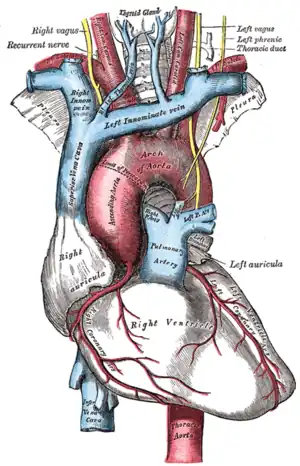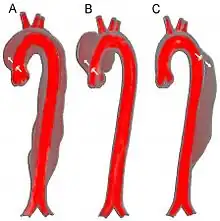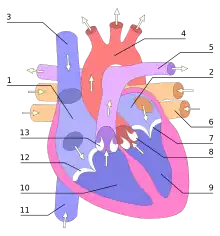Ortner's syndrome
| Ortner's syndrome | |
|---|---|
 | |
| Image of aortic anatomy showing proximity of vagus nerve and its recurrent branch to the aorta | |
| Specialty | Neurology |
Ortner's syndrome is a rare cardiovocal syndrome and refers to recurrent laryngeal nerve palsy from cardiovascular disease.[1] It was first described by Norbert Ortner (1865–1935), an Austrian physician, in 1897.
Dysphagia caused by a similar mechanism is referred to as dysphagia aortica (also called Dysphagia megalatriensis), or, in the case of subclavian artery aberrancy, as dysphagia lusoria. Due to compression of the recurrent laryngeal nerve, it can cause the hoarseness of the voice, which can also be a sign of mitral stenosis. A second Ortner's syndrome, Ortner's syndrome II, refers to abdominal angina.
Causes
Due to its low frequency of occurrence, more common causes of hoarseness should be considered when suspecting left recurrent laryngeal nerve palsy (LRLN).
When considering cardiovocal syndrome, the most common historical cause is a dilated left atrium due to mitral stenosis, but other causes, including pulmonary hypertension,[2] thoracic aortic aneurysms, an enlarged pulmonary artery[3] and aberrant subclavian artery syndrome have been reported compressing the nerve.[4]


Some examples of reported cardiovascular causes include:
- Congenital abnormalities:
- Surgical intervention:
- Transcatheter closure of a PDA [8]
- Incidence: due to the close proximity of the LRLN to the aortic arch, transient paralysis can occur in 10% of cases while permanent effects can occur in 1% of cases. This can further be attributed to using metal clips (used to control bleeding) during the surgical procedure and is more common in premature infants.[8]
- Transcatheter closure of a PDA [8]
- Cardiac disease:
- Left atrial enlargement due to valvular heart disease[9]
- Notable case: A middle-aged male had ongoing cough, hoarseness of voice, and shortness of breath for two years without a history of smoking was found to have mitral valve stenosis due to calcification. This led to left atrial enlargement, elevated pulmonary artery pressure, pulmonary artery hypertension, and right ventricular enlargement. This cardiomegaly, or enlargement of the heart, led to compression of the LRLN.[9]
- Atrial Myxoma[10]
- Aorta:
- Traumatic injury[11]
- Incidence: Although injury to the thoracic aorta is often fatal, in 10% of cases that take longer to present, hoarseness may be the first symptom.[11]
- Aortic dissection[12]
- More commonly affects the right recurrent laryngeal nerve as the most common type of aortic dissection is type A (Figure 2).
- Pseudoaneurysm[13]
- Notable case: A male with long-standing uncontrolled hypertension and hoarseness of voice attributed to life-long smoking was found to have a pseudoaneurysm of the aortic arch which was compressing the LRLN.[13]
- Traumatic injury[11]
- Left atrial enlargement due to valvular heart disease[9]
- Pulmonary disease:
- Pathophysiology: Due to vascular congestion in the lung, the pulmonary artery (Figure 3) becomes dilated and can compress the aorta and the LRLN.[14]
- Malignancy (pulmonary, mediastinal)
- Autoimmune:
- Mixed connective tissue disease[16]
- Notable case: A young female with a history of mixed connective tissue disease presented with hoarseness of voice and was found to have secondary pulmonary artery hypertension. This was causing right heart enlargement and therefore compression of the LRLN.[16]
- Mixed connective tissue disease[16]
- Idiopathic[17]
Diagnosis
It is important to consider a potential cardiovascular cause of hoarseness particularly in patients with progressive disease. Once suspected, performing a laryngoscopy is the first step in identifying damage to the left recurrent laryngeal nerve.[18] Examination includes:
- Swallowing evaluation to assess for risk of aspiration (food going down the trachea instead of the esophagus).
- Breathing testing to rule out incomplete vocal cord closure.
- Voice quality.[19]
History
This correlation between hoarseness of voice and cardiac anatomic pathology was first described by Dr. Norbert Ortner in 1897 after he observed left recurrent laryngeal nerve palsy (LRLN) in three patients with left atrial enlargement secondary to mitral valve stenosis.[20] The definition of Ortner's syndrome has since then expanded to encompass all possible causes of left recurrent laryngeal nerve palsy with cardiac etiologies.
References
- ↑ Bickle IC, Kelly BE, Brooker DS (May 2002). "Ortner's syndrome: a radiological diagnosis". The Ulster Medical Journal. 71 (1): 55–6. PMC 2475354. PMID 12137166.
- ↑ Hermans C, Manocha S, McLaughlin JE, Lipman M, Lee CA (September 2005). "Ortner syndrome and haemophilia". Haemophilia. 11 (5): 548–51. doi:10.1111/j.1365-2516.2005.01140.x. PMID 16128901. S2CID 37404100.
- ↑ Armstrong G. "Mitral Stenosis". Merck Manual. Merck Manual. Retrieved 2015-04-19.
- ↑ Escribano JF, Carnès J, Crespo MA, Antûn RF (January 2006). "Ortner's Syndrome and Endoluminal Treatment of a Thoracic Aortic Aneurysm: A Case Report". Vascular and Endovascular Surgery. 40 (1): 75–78. doi:10.1177/153857440604000111. PMID 16456610. S2CID 46119392.
- 1 2 Condon LM, Katkov H, Singh A, Helseth HK (July 1985). "Cardiovocal syndrome in infancy". Pediatrics. 76 (1): 22–5. PMID 4011354.
- ↑ Krishnamurthy SN, Paulose KO (June 1989). "Vocal cord paralysis with Ebstein's anomaly". The Journal of Laryngology & Otology. 103 (6): 626–628. doi:10.1017/s0022215100109533. PMID 2769036.
- ↑ Borow KM, Hessel SJ, Sloss LJ (1 April 1981). "Fistulous aneurysm of ductus arteriosus". Heart. 45 (4): 467–470. doi:10.1136/hrt.45.4.467. PMC 482551. PMID 7225262.
- 1 2 Fan LL, Campbell DN, Clarke DR, Washington RL, Fix EJ, White CW (October 1989). "Paralyzed left vocal cord associated with ligation of patent ductus arteriosus". The Journal of Thoracic and Cardiovascular Surgery. 98 (4): 611–3. doi:10.1016/S0022-5223(19)34364-8. PMID 2796367.
- 1 2 Subramaniam V, Herle TV, Mohammed N, Thahir M (October 2011). "Ortner's syndrome: case series and literature review". Brazilian Journal of Otorhinolaryngology. 77 (5): 559–562. doi:10.1590/s1808-86942011000500004. PMID 22030961.
- ↑ Rubens F, Goldstein W, Hickey N, Dennie C, Keon W (May 1989). "Hoarseness Secondary to Left Atrial Myxoma". Chest. 95 (5): 1139–1140. doi:10.1378/chest.95.5.1139. PMID 2651037.
- 1 2 Woodson GE, Kendrick B (1 September 1989). "Laryngeal Paralysis as the Presenting Sign of Aortic Trauma". Archives of Otolaryngology–Head & Neck Surgery. 115 (9): 1100–1102. doi:10.1001/archotol.1989.01860330090024. PMID 2765228.
- ↑ Khan IA, Wattanasauwan N, Ansari AW (July 1999). "Painless aortic dissection presenting as hoarseness of voice: cardiovocal syndrome: Ortner's syndrome". The American Journal of Emergency Medicine. 17 (4): 361–3. doi:10.1016/s0735-6757(99)90087-6. PMID 10452434.
- 1 2 Al Kindi AH, Al Kindi FA, Al Abri QS, Al Kemyani NA (October 2016). "Ortner's syndrome: Cardiovocal syndrome caused by aortic arch pseudoaneurysm". Journal of the Saudi Heart Association. 28 (4): 266–269. doi:10.1016/j.jsha.2016.02.006. PMC 5034482. PMID 27688676.
- 1 2 Albertini RE (October 1972). "Vocal Cord Paralysis Associated with Pulmonary Emboli". Chest. 62 (4): 508–510. doi:10.1378/chest.62.4.508. PMID 5078011.
- ↑ Kagal AE, Shenoy PN, Nair KG (April 1975). "Ortner's syndrome associated with primary pulmonary hypertension". Journal of Postgraduate Medicine. 21 (2): 91–5. PMID 126321.
- 1 2 Hirata M, Sunahori-Watanabe K, Isihara M, Shibuto N, Hiramatsu S, Miyawaki Y, et al. (2 January 2018). "Cardiovocal syndrome (Ortner syndrome) associated with secondary pulmonary arterial hypertension in a patient with mixed connective tissue disease". Modern Rheumatology Case Reports. 2 (1): 54–58. doi:10.1080/24725625.2017.1368436. S2CID 79987859.
- ↑ Culp JM, Patel G (January 2020). "Recurrent Laryngeal Nerve Injury". StatPearls. Treasure Island (FL): StatPearls Publishing. PMID 32809667. Retrieved 2020-12-14.
 Text was copied from this source, which is available under a Creative Commons Attribution 4.0 International License.
Text was copied from this source, which is available under a Creative Commons Attribution 4.0 International License. - ↑ Mulpuru SK, Vasavada BC, Punukollu GK, Patel AG (February 2008). "Cardiovocal Syndrome: A Systematic Review". Heart, Lung and Circulation. 17 (1): 1–4. doi:10.1016/j.hlc.2007.04.007. PMID 18055261.
- ↑ Rosen CA, Anderson D, Murry T (June 1998). "Evaluating hoarseness: keeping your patient's voice healthy". American Family Physician. 57 (11): 2775–82. PMID 9636340.
- ↑ Ortner N. (1897). "Recurrent nerve palsy in patient with mitral stenosis." Wien Klin Wochenschr. 1897;10:753–755. [in German]).